Don’t get ahead of yourself but part two of this series can be found HERE.
Upon hitting the scene in 2011 The Disneyland Hotel’s Trader Sam’s Enchanted Tiki Bar became an instant hit. How could it not be? After all, it combines several things Disney does extremely well: heavily themed environments, clever special effects and deep back-story. Of course it also includes alcohol that curiously and inexplicably remains a major draw for many Disney fans (take a trip to Epcot during the food and wine festival for unfortunate, sloppy proof of this).
After enjoying several years as the only Disney Tiki bar (making many of us scratch our heads, bewildered as to why it took over 55 years for Disney to get around to building one), Trader Sam’s expanded this Spring with an all new location in the Polynesian Village Resort at Walt Disney World. The perfect and obvious choice for a Tiki bar now proudly has one (this time called Trader Sam’s Grog Grotto) and the crowds are proving once again that Tiki is back and perhaps poised to become even bigger.
Most people, even non-Disney fans, grasp that the parks inspired both Trader Sam’s locations. They clearly have an Adventureland feel to them (even sharing their names with the Jungle Cruise character) that would be obvious to anyone with rudimentary knowledge of the parks who wandered in. The West Coast version takes most of its inspiration from the Jungle Cruise and The Enchanted Tiki Room while the East Coast incarnation adds elements of the sadly defunct Twenty Thousand Leagues Under the Sea attraction.
In many ways, both locations have finally brought to fruition a concept Walt Disney had dating back to the early days of Disneyland. Over and over again, Imagineering has tried to combine Disney style show elements and exotically themed environments with dining establishments. Famously, the original concept for the Tiki Room started as a restaurant and dinner show before being scaled back to the current show (though you can enjoy Dole Whips inside the original Disneyland version).
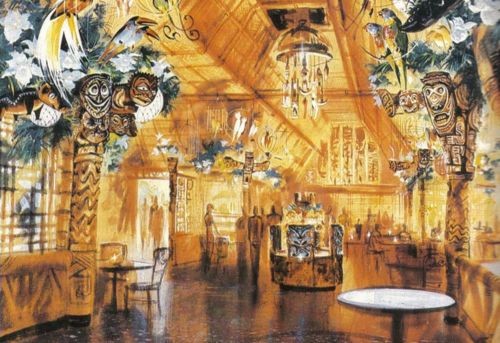
The original concept for the Enchanted Tiki Room has tables and food and feels a lot like Trader Sam’s does today.
The Blue Bayou restaurant in New Orleans Square layered rich environments on top of a dining location and many other Disney restaurants have taken that same path over the years (Epcot’s San Angel Inn, Disneyland’s Tahitian Terrance, The Explorers Club in Disneyland Paris and so on). Even Club 33, the members only, off limits to regular riff-raff, bucket-list worthy private club originally called for interactive animatronics to entertain diners. Yet somehow, over all of this time, Disney had never successfully combined themed environments, attraction-like show elements and dining all in one… they have come close but never quite nailed it.
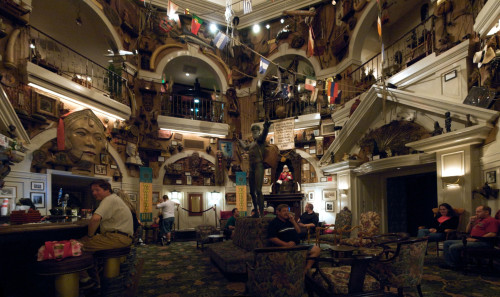
I want to love the Adventurers Club but I could never warm up to it… to much “Kungaloosh!” and not enough charm or whimsy.
The former Adventurers Club, on the also former Pleasure Island, came close. It did have animatronics and show elements in a richly themed environment, but it also had regulars who often took over the property and created an oddly exclusive feel, one in which regular folk were not in on the jokes and unwelcome (Kungaloosh!… oh shut up please). Beyond that, “forced fun” (a somewhat uniquely Disney experience where the pressure to have fun becomes so great that actual fun becomes impossible) would often overwhelm a visit.
The Adventurers Club tried so hard to be fun and irreverent and off beat and spontaneous that it usually failed to be any of these things. It did have a great environment and served drinks and perhaps some simple snacks… however it was basically a comedy club with a bar attached, not really what Walt was going for with his original concept of the Enchanted Tiki Room.
With Trader Sam’s Disney scaled things down, made the room intimate and lavished layer upon layer of thematic details. It may be enjoyed on the simple premise that it is a Tiki bar or one can delve deeper and find hidden jokes and references to past and current attractions. They of course serve Tiki drinks in a variety of exotic and elaborate mugs (as is Tiki bar tradition) and enough food that a group could eat a meal there. Furthermore, there are legitimate show elements happening all around you. Ordering specific drinks will trigger special effect sequences that range from erupting volcanoes to sinking ships. Trader Sam’s is fun, it is for the most part inclusive and is as close to Walt Disney’s concept of the Tiki Room as we are likely to get.
Considering that you are reading this on a website devoted to the small details of the Disney parks you likely know all of this already, in fact you have probably been to one or perhaps both locations. Maybe you have a souvenir Zombie mug sitting on your desk, or maybe you have custom built shelves to hold your complete collection of Tiki mugs (we are not judging you). But few fans have really thought about why any of this exists in the first place, why was Walt so intrigued by Polynesian and Tiki themes? It may have taken six decades to get here but where did it all begin?
Mid-Century America was an interesting time and place. Technology was delivering experiences never before dreamed of. The United States enjoyed an economic and cultural leadership role but also toiled under the “Red Scare” and newfound pressures to move to the suburbs locked into a 30-year mortgage. It was both an exciting and uncharted time filled with humor and a certain synthetic feel. Polyester was better than cotton, frozen food was better than fresh, Monsanto was paving the way to the future and artificial turf was going to replace lawns everywhere: it was the American dream! Disneyland was created at perhaps the only time in history that it could have been, it is very much a reflection of the popular culture of the time. As much as we hate it when Disney tries to be “hip” and “edgy” the truth is that Disneyland has ALWAYS been tied into the zeitgeist. The mid-fifties was a time when multiple trends were emerging within pop culture. Westerns were at their peak (thus Frontierland), the googie architectural movement with its atomic age shapes and space age excitement was in high gear (fueled by the space race over the next 15 years) and so Tomorrowland was born. There was also a fascination with exotic locales and cultures that were foreign to most Americans; the Tiki movement exemplified this and Adventureland became Disneyland’s physical manifestation of it. What later became ironic, kitschy or at worst; tacky, was in fact a hugely popular cultural movement that covered the entire country and lasted over 40 years.
The Tiki movement started in California in 1933 when Ernest Raymond Beaumont Gantt (a young unemployed former prohibition era bootlegger) took the nom de plume of Donn Beach (he later legally adopted this name) and opened up Don the Beachcomber. It was a small bar located in an old tailor’s shop in Hollywood. Decorated with bamboo, thatch roofs and tropical knick-knacks picked up form his island travels, it became an instant smash. Don expanded to a larger location and soon the Hollywood elite (such as Walt Disney) were hanging out drinking the rum and fruit juice cocktails Don concocted with an eye on escapism. Even though these drinks were based on Caribbean liquor and had absolutely nothing to do with the South Pacific (and the actual use of Tiki statues would not come for many years to follow) Tiki as we know it was born.
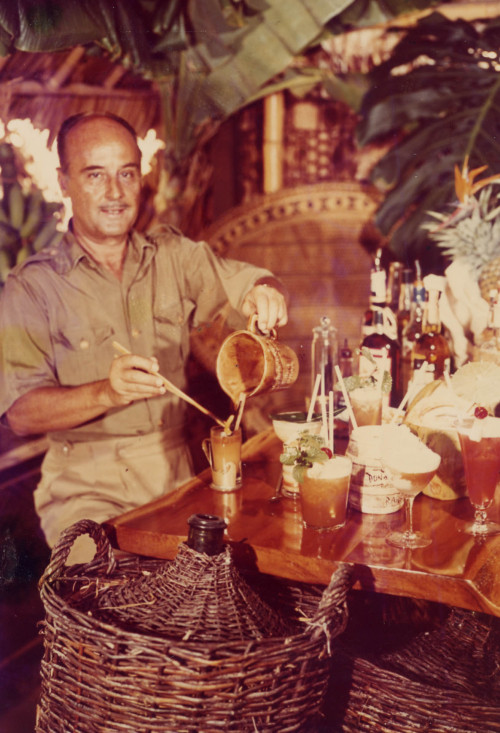
Meet Mr. Beach… without him you would not have Trader Sam’s, the Tiki Room, the Dole Whip or life as you know it.
This was a time when air travel was just becoming democratized, it was just starting to reach a point where an average person could travel great distances. Previously you may be born in Kansas, grow up in Kansas and die in Kansas. Kansas was your world, Kansas was what you knew… the idea of beaches and palm trees and untamed native girls was as far away as the dark side of the moon. Visiting Don’s bar was like traveling across the globe to a fantastic shangri la you never knew existed, or perhaps knew could only exist in a place like this.
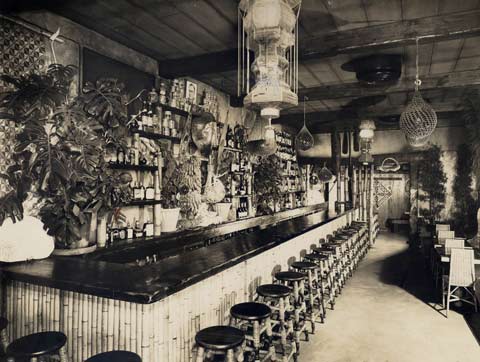
The original Don’s Beachcomber Cafe gave birth to a trend that would last decades and spawn countless copies.
Don served in the Army during World War II and his wife took over and expanded the chain of bars when he was away (16 locations by the time he returned). When the war ended many soldiers came home from the Pacific theater suppressing the horrors they experienced and instead telling stories of uncharted beaches, topless girls and exotic food and drink. The country and the folks who lived and died in Kansas were fascinated. The fact that these tales were mostly fictional and bastardized hodgepodges of Oceanic, Caribbean and African cultures (plus a good heap of pure fantasy) mattered less than the fact that they brought escapism, fun and relief from a long period of conflict. Looking at Tiki bars to learn about Polynesian culture would be like looking at the Country Bear Jamboree to learn about the mating habits of grizzlies; it was all make believe.
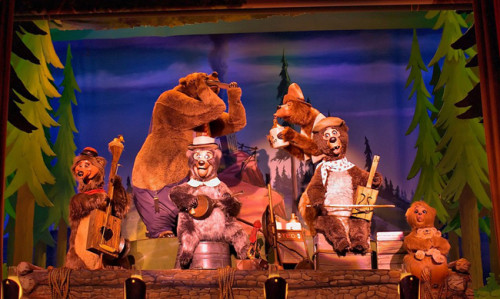
Mating occurs from May through July with a peak in mid-June. Female grizzlies begin bearing young at 3 to 8 years of age, and litter size varies from one to four cubs, with an average litter of two. Grizzly bears have a promiscuous mating system: cubs from the same litter can have different fathers.
The world was getting smaller and these far-off fantasies were tantalizingly within grasp. Hawaii joined the union as our 50th state and interest in Tiki was at an all time high. The parallels of what was happening in popular culture and what Disney was doing, both in entertainment and eventually his park, cannot be overstated.
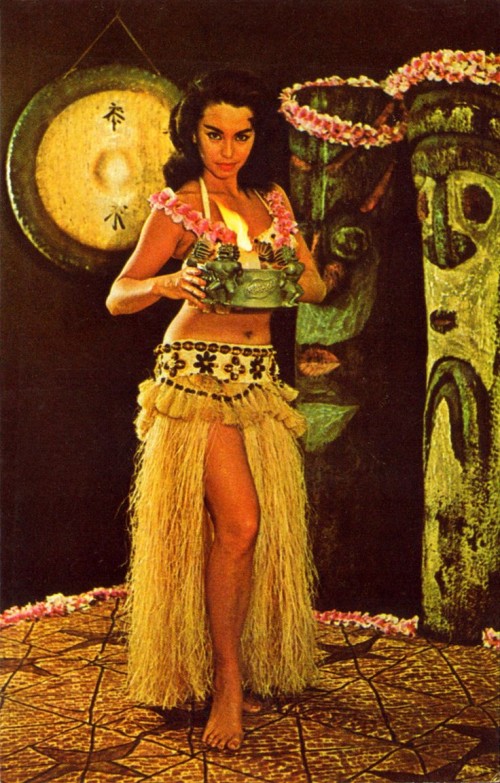
A white girl in a grass skirt with a Chinese gong, a couple South Pacific Tikis, an African patterned rug, Hawaiian leis and holding a flaming drink made with Caribbean rum… all seems pretty authentic and culturally sensitive to me.
Many others joined the Tiki craze, most notably Victor J. Bergeron who opened a series of Trader Vic’s bars and restaurants. Vic brought a culinary element to Don’s mixology and while the two remained amicable rivals throughout their careers they also built upon each other’s successes. Soon patrons all over the world were enjoying “exotic” tropical dishes (really Americanized and homogenized Cantonese recipes) while sipping now classic rum drinks (such as the Mai Tai) in heavily themed, dramatically presented environments. Grand Tiki bars often had a sense of drama not found in your average drinking hole. Dimly lit and often isolated in the basement of hotels (the windowless locations allowed complete control of the environment), many featured waterfalls, grottos and flickering torches. Tribal drum beats, skulls and exotic flora and fauna were highlights. These were in essence Walt’s vision of the Tiki Room sans the singing birds twenty or thirty years before the Tiki Room would see the light of day. They were the prototypes for Adventureland and themed entertainment in general decades before Disneyland defined the genre.
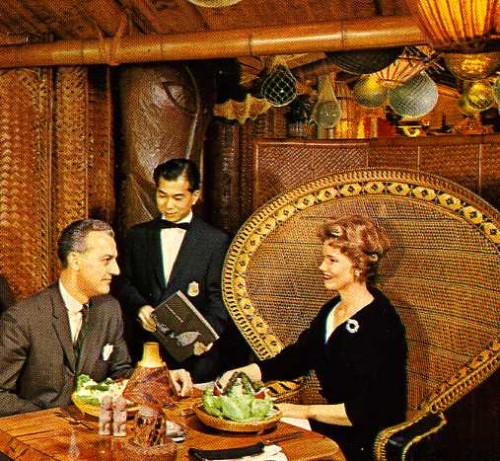
Vic brought food to Tiki, and giant wicker chairs, and volcanoes on tables… and mildy racist stereotypes as well I guess…
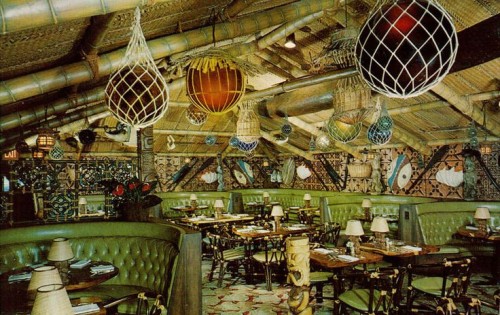
All the New York Trader Vic’s was missing is some wise-cracking talking birds (whose mildly racist stereotypes would fit right in).
The country fell in love; Donn’s little creation became a national obsession. Tiki was not contained simply to bars, by the mid-century it was everywhere; apartment buildings, hotels, bowling alleys, shopping malls, miniature golf, fashion and entertainment. Hula hoops, Hula lamps, Hula dolls and more. Movies such as South Pacific, Blue Hawaii and even Swiss Family Robinson swept audiences away to tropical paradise. Hawaiian shirts were worn without a trace of irony. Home furnishings were fabricated from bamboo and coconut shells. Exotic lounge music (known as exotica and mixing Oceanic and African influences) topped the charts.
Even entire amusement parks were created to celebrate the newly en vogue cultural direction. Tiki enjoyed great longevity running from the mid 1930’s through the 1970’s before finally drifting into the world of kitsch by the 1980’s and off the map altogether in the 90’s and early 2000’s.
Walt Disney’s Enchanted Tiki Room opened during the latter part of the trend in 1963. Tiki was neither invented by Disney nor even re-invented by Disney, it was simply a part of a much larger movement, and it was Disney’s attempt at being “hip” and “edgy” for those times. To be fair Disney did put a spin on it by taking the traditional décor of Tiki and upping the ante with animatronics and theatrical lighting effects. But like much of American culture both Disney, and the Tiki movement in general, stole cultural symbolism and artifacts and transformed them into entertainment for the masses. Many Tiki statues served significant religious roles to cultures not at all understood by the white guys who appropriated them, thus were the ways of mid-century America. Nevertheless the Tiki trend was one of the most significant and widespread of our pop-culture history.
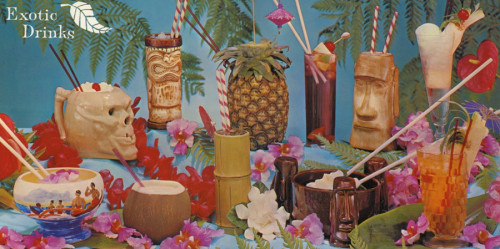
Choose your religious icon of choice, now make it into a mug and serve a boozy slushy out of it… sounds crazy and yet that is exactly what happened.
By the time the seventies came around, Tiki was old enough that those who were interested in it during their youth had kids of their own… those offspring would often look at what their parents thought of as being cool and fun and (in the case of Tiki) escapism, and find it tired, tacky and embarrassing. Tiki was nearing its end. The Vietnam War changed the country’s view of the tropics, palm trees and jungles no longer meant paradise. At this same time American culture was shifting to more realistic and gritty forms of entertainment, cop movies displaced romantic tropical tales at the local theater and elaborately embellished fruity drinks were suddenly passé (not to mention that over the decades they declined in quality from carefully balanced creations to straight from a can syrupy sweet disasters).
Interestingly, Disney was in the midst of building another elaborate homage to Tiki and Polynesia: The Polynesian Village Resort. When Walt Disney World opened in 1971 the “Polynesian” as it was commonly known was one of the original hotels. Complete with Tiki carvings, torches, rain forests, luaus and waterfalls the hotel serves as a last great tribute to the Tiki movement and, in typical Disney fashion, was created just as the trend was ending: Disney never has been good at being hip and edgy after all. Despite all of its many nods to Tiki the Polynesian never had an actual Tiki bar… perhaps even Disney knew the ride was over at that point?
Coming full circle, the Polynesian Village now enjoys it’s own version of Trader Sam’s and Tiki is making a major comeback. Super trendy bars in San Francisco (Smugglers Cove), London (Mahiki), Chicago (Lost Lake, Three Dots and a Dash), New York (PKNY) and elsewhere have spearheaded a renaissance. The kids of the kids who rebelled against Tiki are now embracing it once again, appreciating the creativity and the style the originals brought to the scene. But how are the two Disney versions? After all this time do they capture the spirit of Tiki?
The answer is a definite “maybe”. They are at once classic Tiki and totally anti-Tiki… they are Tiki bars as only Disney could do them.
Stay tuned for part two when we visit both versions of Trader Sam’s and see what they are all about. In the meantime raise a glass to dear old Don the Beachcomber and thank him for all the fun you have had over the years. Without Donn there is no Tiki, no national obsession with Polynesia, no Adventureland and ultimately, perhaps, no Disneyland.
Click HERE to read part two.

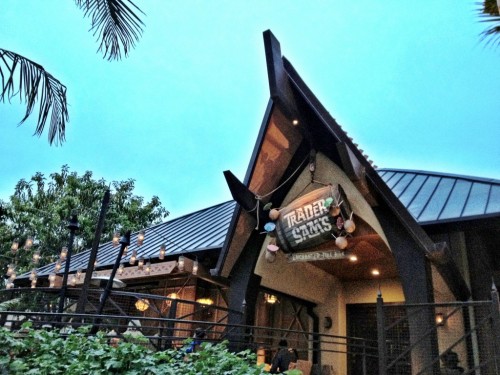
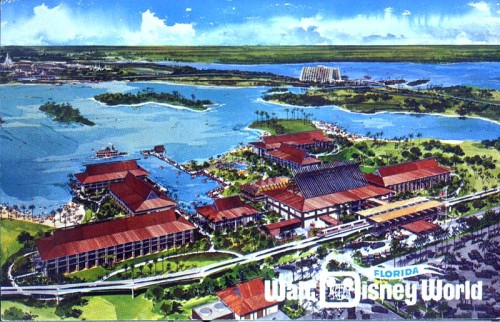
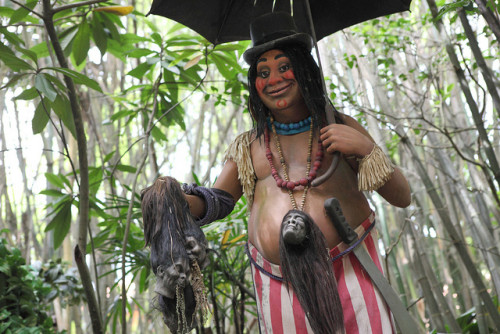
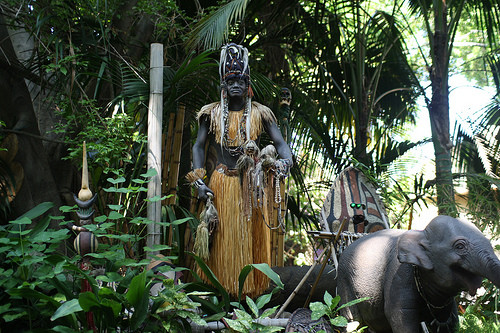
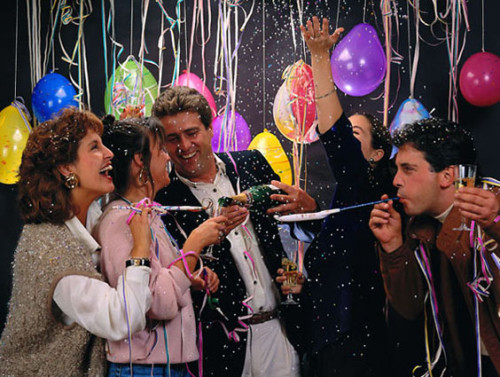
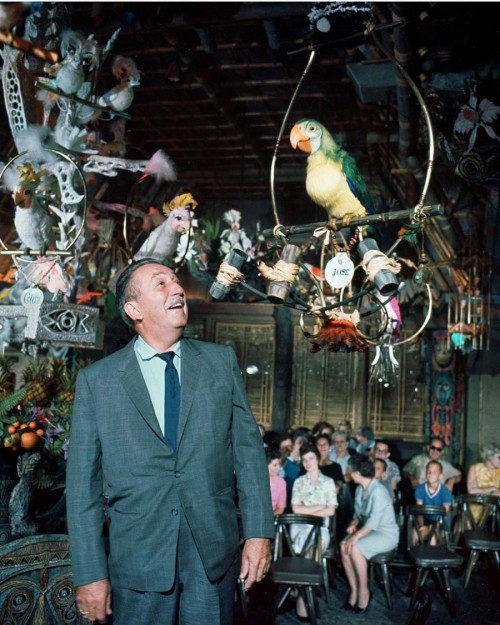
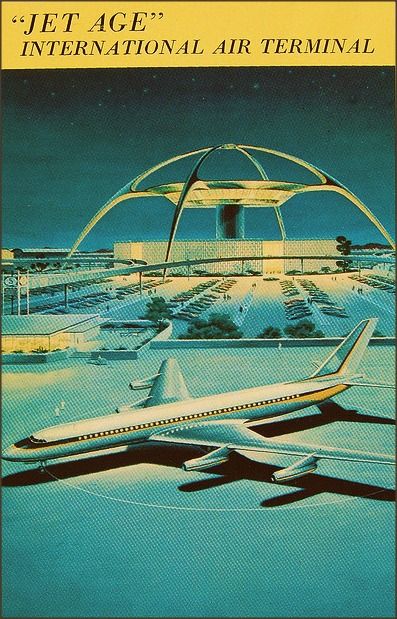
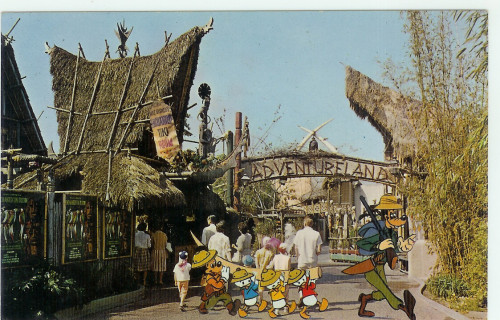
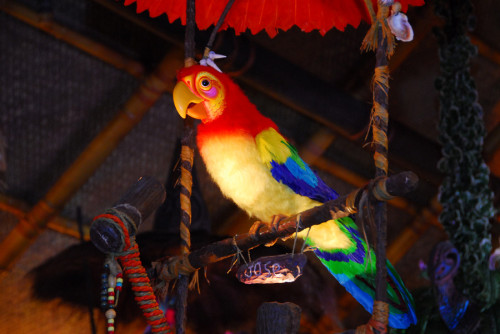
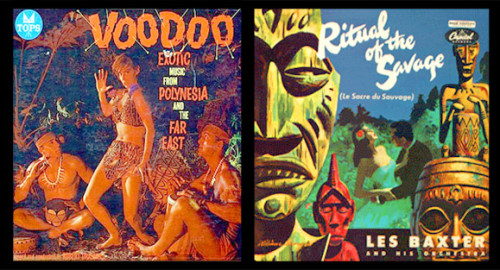
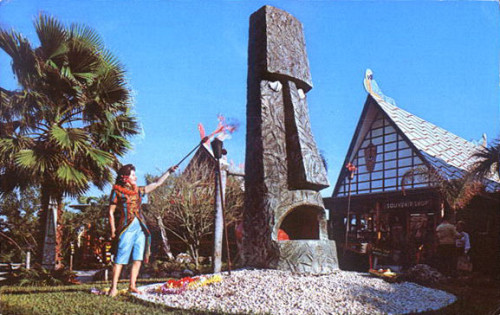
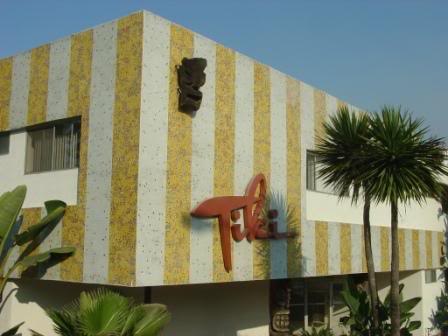
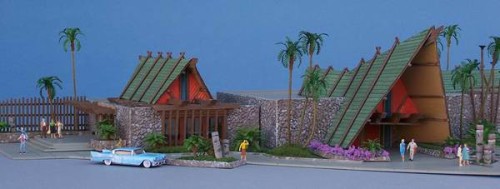
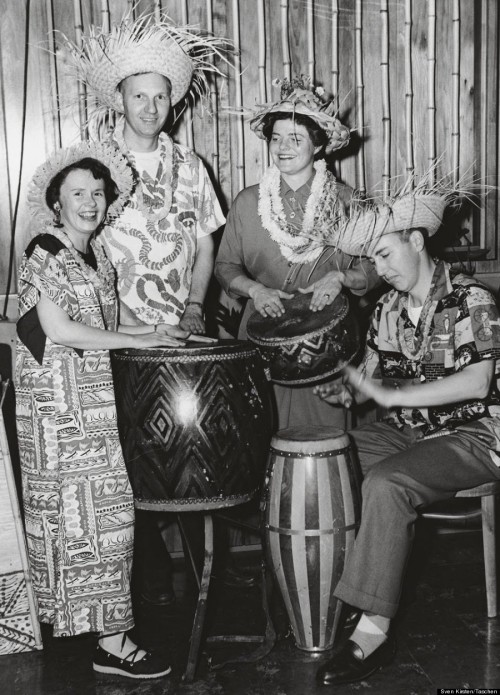
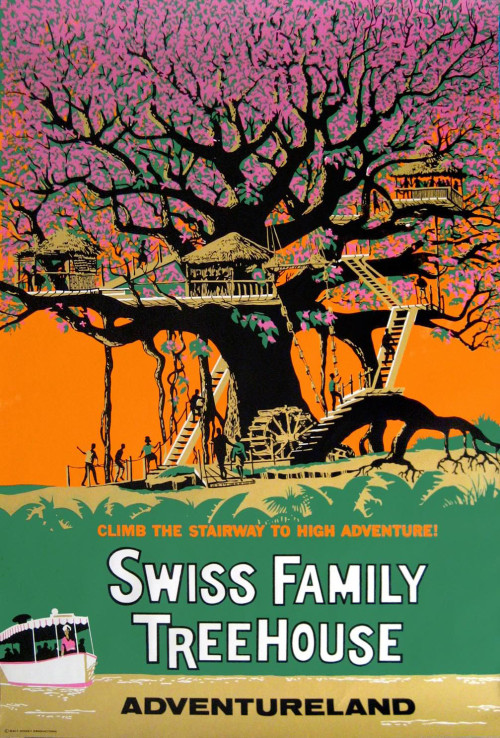
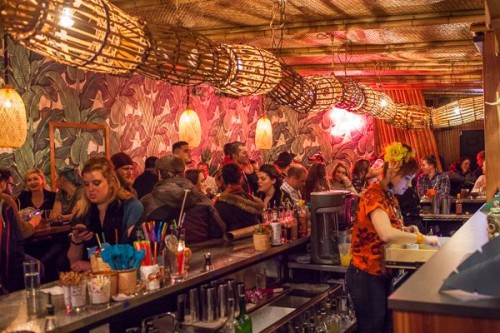
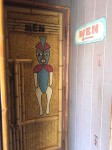


For what it’s worth, that white and yellow striped Tiki apartment is (was?) in Redondo Beach, California.
Actually Trad’r Sams in San Francisco was opened in 1932. It is the oldest Tiki bar that is still open till this day. Personally Disney should have used a different name I think!
Yes a little confusing I agree but worlds apart in pretty much every way.
Thank you for this article! It is both informative and entertaining, and I loved the images you chose, and most of the snarky captions. Your assertion that Tiki is the manifestation of diverse exotic tropical influences viewed through American mid 20th century optimism, and that being a catalyst for the new generation of tiki-philes is spot on with me. I’m 43, living in WA state now, but grew up in Sarasota FL, and visited Disney World many times as a child. My last Disney World visit was when I was around 12 or 13, and I’ve never been to Disneyland. As a young kid, I have vague memories of a stay at the Disney World Polynesian Resort, including a full show Luau. That, along with rides of DW’s Adventure Land (Jungle Cruise, Swiss Family Robinson Tree House, etc.), and re-runs of Gilligan’s Island formed the bamboo shoots that grew into my adult love of Tiki. In the early to mid-2000’s, I discovered Exotica music through the Capitol Records Ultra-Lounge series and an article in the Modern Drunkard online magazine. In the Navy in 2006, I made it to the Trader Vic’s in Dubai. More recently I’ve become enamored with the Hale Pele in Portland OR, and Tacoma WA’s Tacoma Cabana. Now that our kid is nearly 20 and my wife and I have more leisure and income to travel, we’ll be enjoying Tiki Kon in Portland OR/Vancouver WA in July, and are hoping to make it to the Mai Kai in FL later this year, and maybe some of the CA tiki destinations thereafter. I’m anxiously awaiting your follow-on about the Tiki Sam’s locations. Previously I’ve worried visiting a Disney park now would overshadow my childhood memories, but maybe my sense of whimsy deserves a trip to a Trader Sam’s, or the revitalized Polynesian Resort.
Hi Jason… thanks so much, I am glad you enjoyed it.
It is difficult to re-capture those childhood memories… everything will always be better when filtered through those foggy and often rose colored kids glasses. And it is certainly true that the Disney parks (especially WDW) have become more focused on profits and less focused on providing those very types of memories we are discussing (a major mistep in my opinion). HOWEVER the parks are still capable of sparking those types of feelings and especially Disneyland still has much of the charm and excitment that you may recall.
Certainly they are worth visiting again… Part two will delve into some of the specifics and our opinions on the two Trader Sam’s locations… I have a feeling that with your apreciation of modern Tiki culture and your fond Disney memories… you may enjoy both locations.
This doesn’t have anything to do with the article (I’ve already commented above). Through disneyfoodblog.com, I saw that there’s a website, mickeyfix.com, giving away a free Dooney & Bourke Disney bag. To enter, you have to sign up for their newsletter. Why don’t you guys do that? Except instead of the D&B bag, you could give away the sack from Shane’s last t-shirt he bought at DW.
Actually, I opened as Don’s Beachcomber Cafe, and was changed to Don the Beachcomber’s in 1937 after moving across the street to a larger location.
That’s correct Lucky, and we captioned the interior shot of his original location as such. However in the limited scope of this post we tried to keep things more general rather than focus on minutiae such as that. Nevertheless thanks for keeping us honest!
Good article, nice photos. Not everyone “got” the Adventurers Club, so I understand your critiques. But it was an excellent example of live interactive theater, and that’s very hard to pull off.
I LOVED the look of the club. I LOVED the idea of the club. The art direction was very well done etc. etc. Yet every time I would go I always felt like an island awash in a sea of “regulars” who were going through the motions. I take NOTHING away from those who love it and I certainly do not intend to insult them in any way… it just never quite worked for me.
I do agree with you that it is a very difficult thing to pull off.
I totally relate to your feelings about the Adventurer’s Club. I had some very fun times there and loved the concept, but it always sort of felt like I was on the outside of an inside joke. It’s nice to hear that the exclusive vibe wasn’t all in my head. (And as you said, no disrespect intended to those who loved it).
Clearly Colleen there are those who truly live and miss it. Not just the concept of it but the actual experience as well.
Shane has a great analogy: he compares the Adventurers Club to the Rocky Horror Picture Show. If you are in on it, if you enjoy that sort of faux spontaneity, then you love it. But if you are just stopping by (or trying to watch a movie) it’s very off putting.
Tiki by definition should be very relaxing and inclusive so it will be interesting to see how our Trader Sam’s experiences stack up in that regard.
The RHPS analogy is perfect! Love the movie, but throwing pieces of toast doesn’t do much for me. It’s all starting to make sense now… Great article, looking forward to part two.
Down here in Ft Lauderdale Florida we have an original Polynesian restaurant, built in the 50s, called the Mai Kai. It still packs them in for dinner shows and happy hour in the bar. It shows it’s age here and there but is still beloved by locals and tourists alike.
Yes the Mai Kai is famous and one of the last remianing original large scale Tiki bars… it’s a cool place!
Is that possibly Dorthea Redmond’s concept painting of the LAX theme building? The resolution isn’t high enough to tell. I talked to her at the Disney Legend Awards. Her daughter mentioned that her painting of the futuristic theme building also featured the anticipated flying cars, if you look close enough!
I’m honestly not sure Bill. It may be possible but stylistically I’m not sure.
I recently read “Designing Disney” by John Hench and he talked about the original plan to make the Tiki Room a restaurant. It made me think, why not combine food with the tea cups? Makes sense, right? Lewis Carroll was British. How about some fish & chips with some tea? Btw, did you know the English call French fries “chips?” Crazy Brits. Seriously though, I enjoyed the article. Love reading about the history and background of the Disney parks.
Yea Greg… Great idea… Fish and chips and projectile vomiting sounds wonderful.
That’s a great book BTW. I’m glad to know people know about it. I love the books that delve into the design and history of the parks.
Great read. I must admit as a kid in the 80’s that Adventureland and the Polynesian Resort formed the vision of the South Pacific for many years. I recently visited a Trader Vic’s and from that visit I began to research more about the Tiki culture.
It is interesting how much Disneyland captured that seminal pop culture moment of the mid 50’s that came to dominate the last half of the 20th century. I look forward to reading your take on the Trader Sam’s locations and visiting myself next month.
Oh by the way, being from Georgia I can tell you that not only are the Country Bears the place to go for Grizzly mating habits but also they are the go-to spot for male fashion in the South!
Remind me to call you if I need to borrow a pair of cut off jorts.
It’s true though: when you look at Disneyland through the filter of mid century pop culture it all makes perfect sense. Virtually all of Disneyland is a direct reflection of the times. Makes you wonder what it would be if it was originally built in the 80’s or today.
Also it’s cool that you visited Trader Vic’s (Atlanta a presume?). Today most locations are overseas (curiously heavy in the Middle East). At its height there were 25 locations.
It was the Atlanta Trader Vic’s. It had an impressive decor and really good drinks. (both alcoholic and non-alcoholic).
I believe that the Disney Parks’ motif being based on the mid-century optimism is part of the draw of them. DIsneyland was created at the height of Walt Disney’s place in the consciousness of the American public, insuring its popularity. Similarly, this has kept people returning to the parks with their children and grandchildren. This keeps much of this stuff current and exciting for us (who are mostly second generation visitors) as well as our children.
Now about those jorts…
There is still a Trader Vic’s in Portland, OR!! LOVED it!